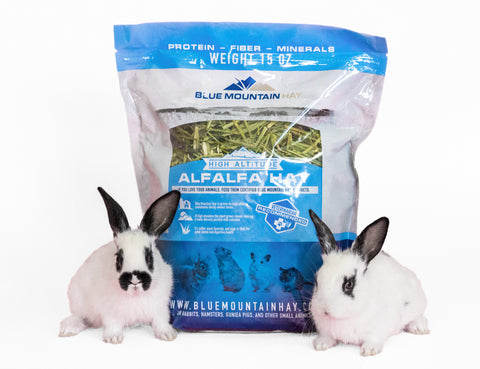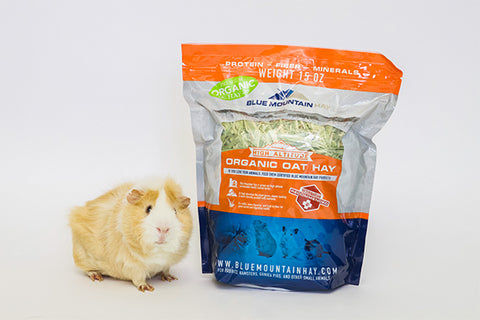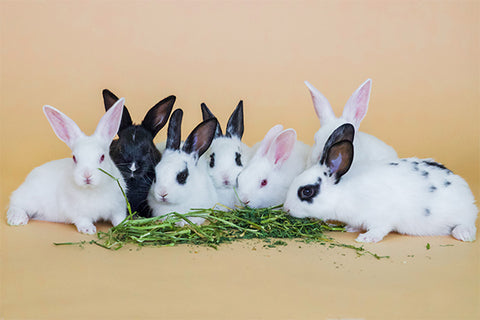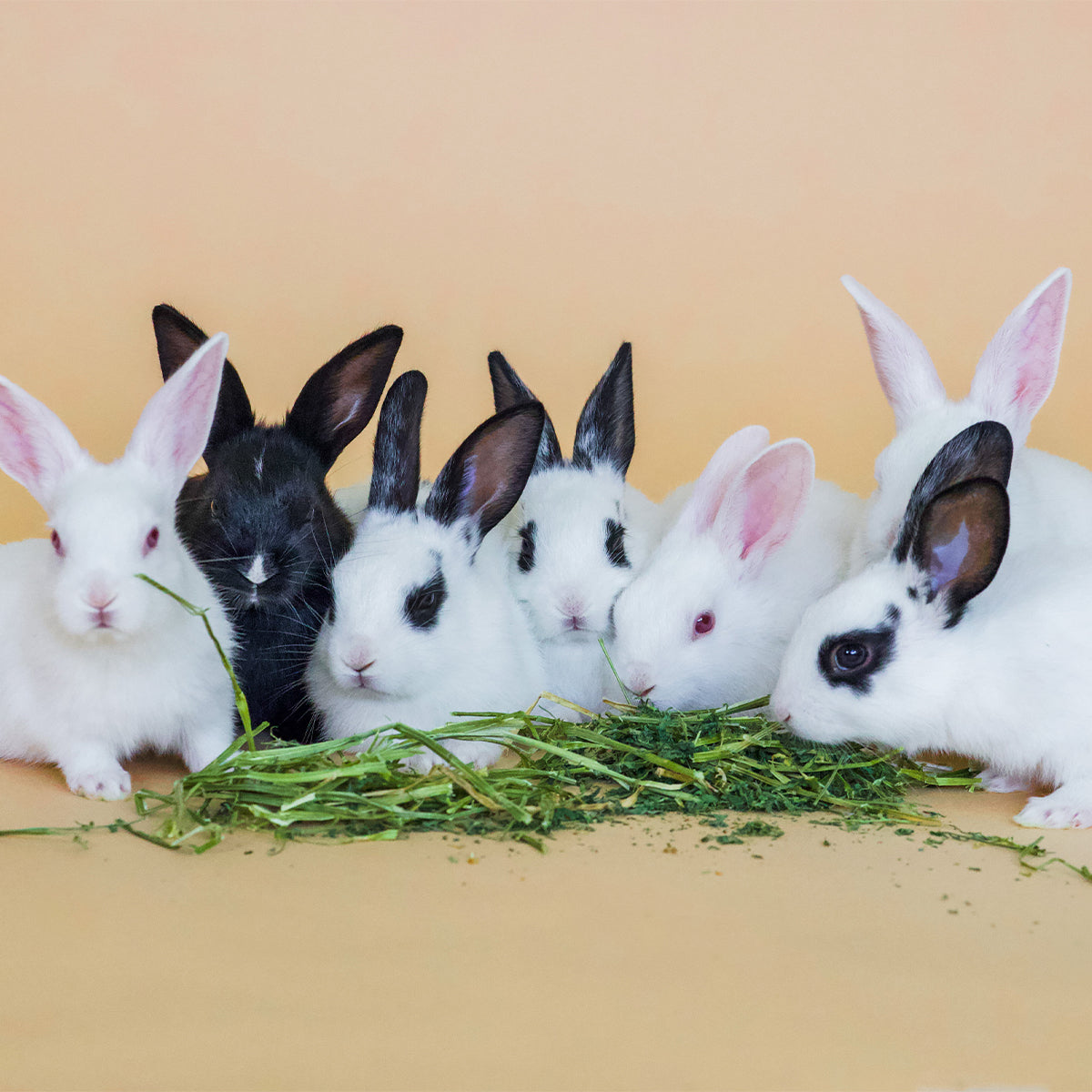Introducing Blue Mountain Hay for small animals, exclusively at Petland! Blue Mountain Hay products are grown at high altitudes in the Pacific Northwest. Growing at high altitudes promotes slow growth which enhances nutrients, digestibility, and flavour. As a family-owned farming company, they believe in nourishing people and pets and have been cultivating high-altitude hay for generations. Petland has partnered with Blue Mountain Hay to bring this superior hay to our Canadian clients.
If you’re reading this, it probably means that you have a beloved rabbit, guinea pig, chinchilla, or degu in your life that is constantly eating hay, and that’s fantastic! The fibre in hay promotes constant digestive movement in these herbivores as their digestive systems operate like motors and function around the clock. Eating hay daily is also important for your herbivore’s teeth, as it helps keep their back molars trimmed by grazing and grinding on the hay all day. Small herbivores should be eating their body size in hay every DAY! It’s important to keep fresh hay in their habitat and replace it as needed.
There are many different varieties of hay out there and it’s tough to know which one to choose as they all have different uses and qualities. Read on as we explore the differences in the types of hay that you see in our stores, as well as who should be eating them, and why each hay is important to your pets’ health!
Ah, timothy hay. The tried-and-true hay that is a staple in all small herbivore diets. Timothy hay is a sweeter hay that is the perfect balance between soft and crunchy, which makes it quite palatable for most small animals. Timothy hay should be given to your pet daily. The best practice is to give the hay in small handfuls frequently as your pet will not want to eat any wet or soiled hay, which means you will waste a lot of hay (and money) if you just give it to them in one big clump every day. It is said that timothy hay tends to be a little on the dusty side, so if you’re worried about your pets or your own allergies, it may be worthwhile to swap your herbivore onto orchard grass hay instead. If you are unsure what kind of hay to get for your pet, you can never go wrong with choosing timothy hay. It’s great for all ages and small herbivorous species!

Alfalfa hay is a sweet and soft legume hay that is nearly irresistible to small herbivores. While it may be irresistible, healthy adult animals should only be given alfalfa hay as an occasional treat. It can, however, be regularly mixed with timothy hay and given to animals who are very young (1-7 months old), pregnant, nursing, underweight, or sick as alfalfa contains more protein and calcium than other grass hays. As your pet matures, consider adding other types of hay, such as Blue Mountain timothy, orchard grass hay, or organic oat hay, for a well-rounded diet. Feeding Alfalfa to animals who do not have these needs can actually be harmful long term as the extra calcium may become too concentrated in their system, which can give them painful and possibly fatal kidney and/or bladder stones. With such high levels of protein and calcium, this dense hay promotes healthy growth and development. Blue Mountain also makes a special hay blend meant specifically for young herbivores that is a nice mix of timothy hay and alfalfa.

Orchard grass hay is a wonderful option for picky pets who need a little more flavour in their lives. It is also great for underweight pets because of how tasty it is. It is sweet and quite soft. Orchard grass hay can be given long-term in place of timothy hay, making it a great timothy hay alternative. It is also less dusty than timothy hay, so if you or your pet gets the sniffles every time fresh hay is offered, maybe consider switching to orchard grass! Another great way to feed orchard grass to your pet is to mix it with timothy hay as it helps create variety in your pet’s meals and prevent boredom.

Something that is great about organic meadow hay is that it is just the right combination of soft and crunchy, but it’s also sweeter than timothy hay, meaning that it is more palatable (good for picky pets!). Meadow hay is made with a blend of soft-stemmed pasture grasses and natural herbs. This hay promotes healthy foraging behaviours and offers a softer texture for maximum comfort. Blue Mountain Hay’s meadow hay is 100% organically grown without the use of any chemicals. A great way to provide variety to your pet’s diet is to mix meadow hay with your pet’s timothy hay or orchard grass.

Oat hay is incredibly hardy and the highest in fibre on this list. It is much crunchier than the other hays we’ve talked about, and it is also higher in fat and carbohydrates, so you must keep an eye on pets who eat this frequently as it can lead to slow weight gain or gastrointestinal issues due to the extra amount of simple carbohydrates (feeding a variety of hay can prevent this). This hay makes a great treat or daily mix in with your pet’s regular hay blend as it is so high in fibre, just make sure to not give too much!

Teff hay is a newer hay to the small pet market. It was previously only popular with larger herbivores and livestock. Teff hay holds one large benefit over timothy in that it is very soft but still very hardy and high in fibre. Teff is an ancient grass hay originating in Africa. Teff can be fed the same as timothy and is a great option for overweight or diabetic full-grown small animals. It is low in sugar, and it is a great source of protein, fibre, vitamins, calcium, phosphorus, iron, copper, and other minerals. The only downside is that some pickier herbivores may not like it as much as the sweeter varieties.

I’ve Picked a New Hay… Now What?
Small herbivores can be finicky eaters, which means that even if you keep with the same kind of hay but switch brands, they may be hesitant to eat the new hay right away. Different fields offer different cuts and qualities of hay. It’s important that when transitioning your pets onto any kind of food (whether it be pellets or hay), you gradually mix the new food with the old food and wean them onto what you will be feeding them going forward.




